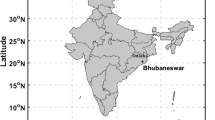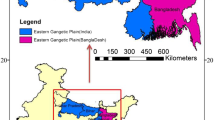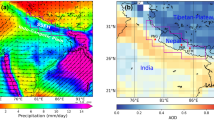Abstract
Clouds and aerosols contribute substantial uncertainty to the estimation of precipitation patterns at the global and regional scale. The present study focuses on understanding spatiotemporal and vertical variability in aerosol–cloud interactions over western India and the Arabian Sea. The study was conducted for the period 2000–2018 using data from the Moderate Resolution Imaging Spectroradiometer (MODIS) and Tropical Rainfall Measuring Mission (TRMM) satellites and a regional climate model. In situ measurements of rainfall for western India from the India Meteorological Department (IMD) were also used. High values of aerosol optical depth (0.21–1.10) were observed for deficit rain, whereas low values (0.15–0.85) accounted for excess rain over western India. Over both regions, a negative linear correlation between aerosol optical depth and cloud effective radius and between aerosol optical depth and precipitation rate for excess, normal, and deficit rainfall conditions, with variations in correlation coefficient and slope values for the three monsoon conditions. In general, higher slope values were observed for excess rain over both regions, signifying a greater rate of change in cloud effective radius and precipitation rate with change in aerosol optical depth. Simulated cloud parameters including fractional cloud cover and the mass fraction of cloud liquid water content showed significant vertical variability for different monsoon conditions along different latitudes and longitudes for western India and the Arabian Sea, respectively.







Similar content being viewed by others
Data availability
Satellite data has been available through online web portal of Giovanni, Earth Data. Rainfall data has been taken from IMD web portal. Input datasets for model simulations have been available from ICTP web portal. Details of all the datasets are included in the acknowledgement section.
References
Acker, J. G., & Leptoukh, G. (2007). Online analysis enhances use of NASA earth science data. Eos Transactions American Geophysical Union, 88(2), 14–17.
Benson, C. L., Jr., & Rao, G. V. (1987). Convective bands as structural components of an Arabian Sea convective cloud cluster. Monthly Weather Review, 115(12), 3013–3023.
Bhandari, S., Srivastava, R., & Mehta, V. (2016). Long-term changes in the within-season temporal profile of southwest monsoon over western India. Journal of Earth System Science, 125(7), 1313–1319.
Cheung, H. C., Chou, C. C. K., Lee, C. S. L., Kuo, W. C., & Chang, S. C. (2020). Hygroscopic properties and cloud condensation nuclei activity of atmospheric aerosols under the influences of Asian continental outflow and new particle formation at a coastal site in eastern Asia. Atmospheric Chemistry and Physics, 20(10), 5911–5922.
Dave, P., Bhushan, M., & Venkataraman, C. (2017). Aerosols cause intraseasonal short-term suppression of Indian monsoon rainfall. Scientific Reports. https://doi.org/10.1038/s41598-017-17599-1
Dey, S., Nishant, N., Sengupta, K., & Ghosh, S. (2015). Cloud climatology over the oceanic regions adjacent to the Indian Subcontinent: Inter-comparison between passive and active sensors. International Journal of Remote Sensing, 36(3), 899–916.
Dube, A., Ashrit, R., Ashish, A., Sharma, K., Iyengar, G. R., Rajagopal, E. N., & Basu, S. (2014). Forecasting the heavy rainfall during Himalayan flooding—June 2013. Weather and Climate Extremes, 4, 22–34.
Emanuel, K. A. (1991). A scheme for representing cumulus convection in large-scale models. Journal of the Atmospheric Science, 48(21), 2313–2329.
Fan, C., Ding, M., Wu, P., & Fan, Y. (2018). the relationship between precipitation and Aerosol: Evidence from satellite observation Physics. arXiv preprint, 1812, 02036.
Gadgil, S., & Joseph, P. V. (2003). On breaks of the Indian monsoon. Journal of Earth System Science, 112(4), 529–558.
Gautam, S., Elizabeth, J., Gautam, A. S., Singh, K., & Abhilash, P. (2022). Impact assessment of aerosol optical depth on rainfall in Indian rural areas. Aerosol Science and Engineering, 6(2), 186–196.
Gayatri, K., Patade, S., & Prabha, T. V. (2017). Aerosol-cloud interaction in deep convective clouds over the Indian Peninsula using spectral (bin) microphysics. Journal of the Atmospheric Sciences, 74(10), 3145–3166.
Grell, G. A. (1993). Prognostic evaluation of assumptions used by cumulus parameterizations. Monthly Weather Review, 121(3), 764–787.
Gudoshava, M., & Semazzi, F. H. (2019). Customization and validation of a regional climate model using satellite data over East Africa. Atmosphere, 10(6), 317.
Hai, L., Miaoxin, X., Chong, W., Yaokui, H., & Shouxiang, Z. (1985). Ground-based remote sensing of LWC in cloud and rainfall by a combined dual-wavelength radar-radiometer system. Advances in Atmospheric Sciences, 2(1), 93–103. https://doi.org/10.1007/bf03179741
Huffman, G.J, D.T. Bolvin, E.J. Nelkin, and R.F. Adler. (2016). TRMM (TMPA) Precipitation L3 1 day 0.25 degree x 0.25 degree V7, Edited by Andrey Savtchenko, Goddard earth sciences data and information services center (GES DISC), Accessed January 7 2021.
Jasmine, M., Aloysius, M., Jayaprakash, R., Fathima, C., Prijith, S., & Mohan, M. (2022). Investigation on the role of aerosols on precipitation enhancement over Kerala during August 2018. Atmospheric Environment., 279, 119101. https://doi.org/10.1016/j.atmosenv.2022.119101
Jin, Q., & Wang, C. (2018). The Greening of northwest Indian subcontinent and reduction of dust abundance resulting from Indian summer monsoon revival. Scientific Reports. https://doi.org/10.1038/s41598-018-23055-5
Jin, Q., Wei, J., Lau, W. K., Pu, B., & Wang, C. (2021). Interactions of Asian mineral dust with Indian summer monsoon: Recent advances and challenges. Earth-Science Reviews, 215, 103562. https://doi.org/10.1016/j.earscirev.2021.103562
Kaskaoutis, D. G., Gautam, R., Singh, R. P., Houssos, E. E., Goto, D., Singh, S, & Takemura, T. (2012). Influence of anomalous dry conditions on aerosols over India: transport, distribution and properties. Journal of Geophysical Research: Atmospheres. 117(D9).
Kok, J. F., Storelvmo, T., Karydis, V. A., Adebiyi, A. A., Mahowald, N. M., Evan, A. T., & Leung, D. M. (2023). Mineral dust aerosol impacts on global climate and climate change. Nature Reviews Earth & Environment, 4, 1–16.
Komkoua Mbienda, A. J., Guenang, G. M., Tanessong, R. S., Ashu Ngono, S. V., Zebaze, S., & Vondou, D. A. (2021). Possible influence of the convection schemes in regional climate model RegCM4.6 for climate services over Central Africa. Meteorological Applications, 28(2), e1980.
Kothawale, D. R, & Rajeevan, M. (2017). Monthly, Seasonal and annual rainfall time series for all-India, homogeneous regions and meteorological subdivisions: 1871–2016. Pune: Indian Institute of Tropical Meteorology.
Kumar, H., & Tiwari, S. (2023). Climatology and trend of aerosol-cloud parameters and their correlation over the Northern Indian Ocean. Geoscience Frontiers, 14, 101563.
Leena, P. P., Sravanthi, N., Anil Kumar, V., Pandithurai, G., & Panicker, A. S. (2021). Aerosol–Cloud–rainfall properties inferred from satellite observations over different regions of the Indian subcontinent: variability, trends and relationships during the summer monsoon. Pure and Applied Geophysics, 178, 4619–4631.
Levy, R. C, Remer, L. A, & Dubovik, O. (2007). Global aerosol optical properties and application to Moderate Resolution Imaging Spectroradiometer aerosol retrieval over land. Journal of Geophysical Research: Atmospheres, 112(D13).
Levy, R. C., Remer, L. A., Kleidman, R. G., Mattoo, S., Ichoku, C., Kahn, R., & Eck, T. F. (2010). Global evaluation of the collection 5 MODIS dark-target aerosol products over land. Atmospheric Chemistry and Physics, 10(21), 10399–10420.
Lohmann, U. (2002). A glaciation indirect effect caused by soot aerosols. Geophysical Research Letters. https://doi.org/10.1029/2001GL014357
Mehta, M., Sharma, P., & Chauhan, P. (2022). Changing trends of aerosol loadings over three major zones of Indian region during the last seventeen years (2005–2021). Journal of the Indian Society of Remote Sensing, 50(7), 1405–1408. https://doi.org/10.1007/s12524-022-01533-8
Mishra, V. (2021). Looking back into history to understand droughts. India Water Portal. https://www.indiawaterportal.org/articles/looking-back-history-understand-droughts#:~:text=18%20meteorological%20and%2016%20hydrological,%2C%201918%2C%201965%20and%202000.
Mukherjee, A. K., Gurunadham, G., & Padmanabham, K. P. (1978). Clouding over the Arabian Sea and the synoptic situation over India during monsoon. Mausam, 29(1), 118–124.
Mukherjee, A. K., & Kumar, S. (1976). Cumulonimbus tops around Bombay Indian. Journal of Meteorology Hydrology & Geophysics, 27, 303–308.
Mukherjee, S., Aadhar, S., Stone, D., & Mishra, V. (2018). Increase in extreme precipitation events under anthropogenic warming in India. Weather and Climate Extremes, 20, 45–53.
Nakajima, T., & King, M. D. (1990). Determination of the optical thickness and effective particle radius of clouds from reflected solar radiation measurements part I: Theory. Journal of Atmospheric Science, 47(15), 1878–1893.
Ng, D. H. L., Li, R., Raghavan, S. V., & Liong, S. Y. (2017). Investigating the relationship between aerosol optical depth and precipitation over Southeast Asia with relative humidity as an influencing factor. Scientific Reports, 7(1), 1–13.
Nober, F. J., Graf, H. F., & Rosenfeld, D. (2003). Sensitivity of the global circulation to the suppression of precipitation by anthropogenic aerosols. Global and Planetary Change, 37(1–2), 57–80.
Ogura, Y., & Yoshizaki, M. (1988). Numerical study of orographic-convective precipitation over the eastern Arabian Sea and the Ghat Mountains during the summer monsoon. Journal of the Atmospheric Sciences, 45(15), 2097–2122.
Pal, I., & Al-Tabbaa, A. (2010). Regional changes in extreme monsoon rainfall deficit and excess in India. Dynamics of Atmospheres and Oceans, 49(2–3), 206–214.
Patil, N., Dave, P., & Venkataraman, C. (2017). Contrasting influences of aerosols on cloud properties during deficient and abundant monsoon years. Scientific Reports, 7(1), 1–9.
Perlwitz, J., & Miller, R. L. (2010). Cloud cover increase with increasing aerosol absorptivity: A counterexample to the conventional semidirect aerosol effect. Journal of Geophysical Research: Atmospheres, 115(D8).
Purohit, M. K. & Kaur S. (2016). Rainfall statistics of India-2016 (Report No. ESSO/IMD/HS/R.F.REPORT/01(2017)/23). Retrieved from Indian Meteorological department, Ministry of Earth sciences. http://hydro.imd.gov.in/hydrometweb/(S(ah0kjd55lgvs5siowd4f0jvl))/PRODUCTS/Publications/Rainfall%20Statistics%20of%20India%20-%202016/Rainfall%20Statistics%20of%20India%20-%202016.pdf.
Rahul, P. R. C., Salvekar, P. S., & Devara, P. C. S. (2008). Aerosol optical depth variability over Arabian Sea during drought and normal years of Indian monsoon. Geophysical Research Letters. https://doi.org/10.1029/2008GL035573
Rajput, N., Dave, H., James, M.E., Ray, K., & Simon, B. (2011). Study of intense rainfall over Gujarat during Monsoon 2011 with special reference to offshore trough: In Sh. D. R. Sikka, AVM (Dr.) Ajit Tyagi (Eds.), TROPMET-2011 “Meteorology for socio-economic development” (pp. 13–25).
Ramachandran, S., & Cherian, R. (2008). Regional and Seasonal variations in aerosol optical characteristics and their frequency distributions over India during 2001–2005. Journal of Geophysical Research: Atmosphere, 113(D8).
Ramachandran, S., & Kedia, S. (2013a). Aerosol, clouds and rainfall: Inter-annual and regional variations over India. Climate Dynamics, 40(7), 1591–1610.
Ramachandran, S, & Kedia, S. (2013b). Aerosol-precipitation interactions over India: review and future perspectives. Advances in Meteorology.
Randles, C. A, & Ramaswamy, V. (2008). Absorbing aerosols over Asia: A geophysical fluid dynamics laboratory general circulation model sensitivity study of model response to aerosol optical depth and aerosol absorption. Journal of Geophysical Research: Atmospheres, 113(D21).
Rao, G. V., & Hor, T. H. (1991). Observed momentum transport in monsoon convective cloud bands. Monthly Weather Review, 119(4), 1075–1087.
Rao, Y. P. (1976). Southwest monsoon New Delhi: India meteorological department. Natural Hazards, 84, 425.
Remer, L. A., Kaufman, Y. J., Tanre, D., Mattoo, S., Chu, D. A., Martins, J. V., Li, R. R., Ichoku, C., Levy, R. C., Kleidman, R. G., Eck, T. F., Vermote, E., & Holben, B. N. (2005). The MODIS aerosol algorithm, products, and validation. Journal of Atmospheric Science, 62, 947–973.
Roxy, M. K., Ghosh, S., Pathak, A., Athulya, R., Mujumdar, M., Murtugudde, R., & Rajeevan, M. (2017). A threefold rise in widespread extreme rain events over central India. Nature communications, 8(1), 1–11.
Sarangi, C., Kanawade, V. P., Tripathi, S. N., Thomas, A., & Ganguly, D. (2018). Aerosol-induced intensification of cooling effect of clouds during Indian summer monsoon. Nature Communications, 9(1), 1–9.
Sarkar, S., Chauhan, A., Kumar, R., & Singh, R. P. (2019). Impact of deadly dust storms (May 2018) on air quality, meteorological, and atmospheric parameters over the northern parts of India. GeoHealth, 3(3), 67–80.
Satheesh, S. K., Vinoj, V., & Krishnamoorthy, K. (2010). Assessment of aerosol radiative impact over oceanic regions adjacent to Indian subcontinent using multisatellite analysis. Advances in Meteorology, 2010(1), 13.
Shah, R., & Srivastava, R. (2018). Evaluation of to get cloud and monsoon features with seasons over India. International Journal of Environmental Science and Development, 9(10), 303.
Shah, R., & Srivastava, R. (2019). Effect of climate change on cloud properties over Arabian Sea and central India. Pure and Applied Geophysics, 176, 2729–2738.
Shah, R., & Srivastava, R. (2020). Effect of Ocean warming on cloud properties over India and adjoining oceanic regions. Pure and Applied Geophysics, 177, 5911–5925.
Shah, R., & Srivastava, R. (2022). Simulation of ambient parameters using Grell convective scheme to study rainfall heterogeneity over western India. Materials Today: Proceedings, 67, 833–837.
Sijikumar, S., & Rajeev, K. (2012). Role of the Arabian Sea warm pool on the precipitation characteristics during the monsoon onset period. Journal of Climate, 25(6), 1890–1899.
Singh, C., Thomas, L., & Kumar, K. K. (2017). Impact of aerosols and cloud parameters on Indian summer monsoon rain at intraseasonal scale: A diagnostic study. Theoretical and Applied Climatology, 127(1), 381–392.
Singh, P. (2018). Indian summer monsoon rainfall (ISMR) forecasting using time series data: A fuzzy-entropy-neuro based expert system. Geoscience Frontiers, 9(4), 1243–1257.
Smith, R. B. (1979). The influence of mountains on the atmosphere in advances in geophysics. Elsevier.
Srivastava, A. K., Tiwari, S., Devara, P. C. S., Bisht, D. S., Srivastava, M. K., Tripathi, S. N., & Holben, B. N. (2011). Pre-monsoon aerosol characteristics over the Indo-Gangetic Basin: implications to climatic impact. Annales Geophysicae, 29(5), 789–804.
Srivastava, R., & Shah, R. (2019). Study of monsoonal features using regional climate model over heterogeneous monsoon dominated region. E3S Web of Conferences, 101, 03004.
Trends, C. (2020). Explained: Why parts of India are seeing extreme rainfall and floods. The Quint. https://www.thequint.com/explainers/jaipur-rains-why-parts-of-india-are-witnessing-extreme-rainfall-and-floods-explained#read-more.
Twomey, S. (1977). The influence of pollution on the shortwave albedo of clouds. Journal of the Atmospheric Science, 34, 1149–1152.
Van de Boogaard, H. (1977). The mean circulation of the tropical and subtropical atmosphere. National Center for Atmospheric Research, 26(3), 229.
Willett, K. M., Gillett, N. P., Jones, P. D., & Thorne, P. W. (2007). Attribution of observed surface humidity changes to human influence. Nature, 449(7163), 710–712.
Yadav, B. P. et al. (2016). Rainfall statistics of India-2017 (Report No. ESSO/IMD/HS/R.F.REPORT/01(2017)/24). Retrieved from Indian Meteorological department, Ministry of EarthSciences.website:http://hydro.imd.gov.in/hydrometweb/(S(ot5cmtuc1kjcfr55jsuioxqi))/PRODUCTS/Publications/Rainfall%20Statistics%20of%20India%20-%202017/Rainfall%20Statistics%20of%20India%20-%202017.pdf.
Acknowledgements
The authors would like to thank the Department of Science and Technology-Science and Engineering Research Board, India, for granting the Fast Track Project (ECR/2017/002000). Also, we wish to acknowledge the online web portal of Giovanni, Earth Data, for providing satellite retrievals of MODIS and TRMM (https://giovanni.gsfc.nasa.gov/giovanni/). For regional climate model simulations, input datasets from NNRP1 and EIN75 have been utilized. Along with this, rainfall data have been taken from ground-based measurements through the IMD web portal.
Funding
No funding has been taken for this publication.
Author information
Authors and Affiliations
Contributions
Rohit Srivastava has contributed significantly in this research work, which includes scientific theme, analysis, conception and design of the manuscript. Ruchita Shah has drafted and organized the manuscript. JP and Ruchita Shah both have collected the data, organized along with its analysis. SS and BV have given their scientific contribution as well as editing of all the prepared drafts. DP has improved the language of the manuscript with high English proficiency. Ruchita Shah and DP have revised the manuscript according to the reviewers and have incorporated their suggestions. All the authors have read and approved the final manuscript.
Corresponding author
Ethics declarations
Conflict of interest
No conflict of interests for this publication.
Additional information
Publisher's Note
Springer Nature remains neutral with regard to jurisdictional claims in published maps and institutional affiliations.
Rights and permissions
Springer Nature or its licensor (e.g. a society or other partner) holds exclusive rights to this article under a publishing agreement with the author(s) or other rightsholder(s); author self-archiving of the accepted manuscript version of this article is solely governed by the terms of such publishing agreement and applicable law.
About this article
Cite this article
Srivastava, R., Shah, R., Sharma, S. et al. A Study of Aerosol–Cloud Variability under Different Rainfall Scenarios over Western India and the Arabian Sea. Pure Appl. Geophys. 180, 3035–3052 (2023). https://doi.org/10.1007/s00024-023-03305-y
Received:
Revised:
Accepted:
Published:
Issue Date:
DOI: https://doi.org/10.1007/s00024-023-03305-y




